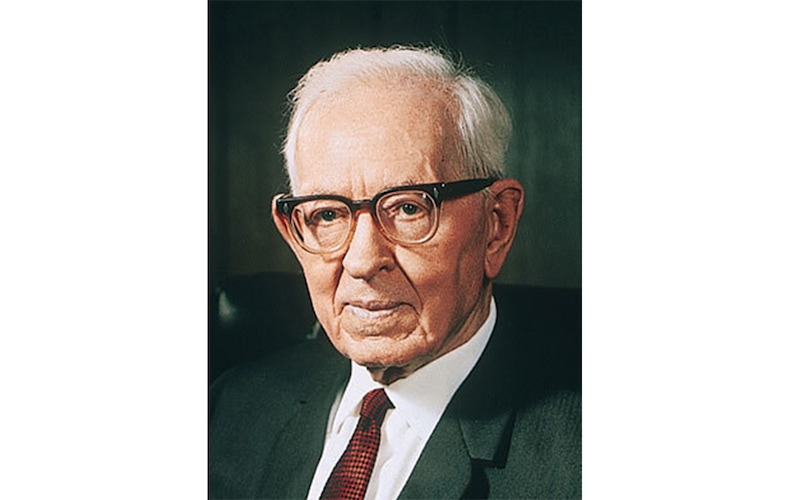The Church of Jesus Christ of Latter-day Saints recently published a religion and science addition to its Topics and Questions series addressing four subjects: the general compatibility of science and religion; the church’s stance on evolution and the origin of humans; reconciling scriptural teachings about creation with science; and the relationship between medical science and faith.
For those with eyes to see, the content of this short Q&A continues a trajectory away from a highly vocal and dogmatic young-Earth creationism, which reads scripture as a divinely omniscient scientific text with a high degree of confidence. That midcentury trend, largely under the influence of eventual church President Joseph Fielding Smith, represented a deviation from an earlier intellectual humility, which included a wary openness to the science of biological evolution and a positive view of Darwin. Fielding Smith’s father, church President Joseph F. Smith, did not think evolution valid, but wrote that “Charles Darwin [is] one of the most able and devoted students of nature the world has known, and as an investigator whose labors have been of incalculable good to mankind.”

(The Church of Jesus Christ of Latter-day Saints) Theologian Joseph Fielding Smith, former president of The Church of Jesus Christ of Latter-day Saints, challenged scientists on the age of Earth.
As has always been the case with supposed science-religion conflict, the true division is not between believers and atheists, nor scholars versus clergy, nor even science against religion. Rather, it is about varied interpretations of scientific data in conflict with varied interpretations of scripture and tradition, themselves based on historical knowledge and the assumptions each person brings to scripture.
In reality, scholars, believers and clergy have been on all sides of such science-religion issues. With Darwinian evolution, for example, many supporters were Christian scholars of some kind (such as B.B. Warfield) and many who opposed his natural selection were scientists (such as Lord Kelvin, of Kelvin heat scale fame. Not knowing about the heat from radiation, he thought the Earth’s temperature indicated it was not old enough to allow for evolution). Shallow understanding or dogmatism does no parties any favors, regardless of presuppositions or leanings.
(Maull and Fox) Charles Darwin, circa 1854.
To that point, the church’s essay emphasizes intellectual humility and the nonscientific nature of scripture in at least limited contexts. “The Creation accounts in the scriptures,” it states, “are not scientific descriptions.”
Similar rhetoric emphasizes the role of human discovery in revealing truth, along with divine revelation. “Any apparent conflicts between science and religion,” the piece adds, “will ultimately be resolved through more careful study, further scientific research, or continuing revelation.”
Stepping back, a century ago the boundaries of science and religion were heavily contested. The latest essay demonstrates the church today recognizes a fairly standard boundary wherein science is mostly independent. Joseph Fielding Smith and others disputed such a demarcation, but various First Presidencies have affirmed it, likely under the influence of Latter-day Saint scientists such as apostles James E. Talmage and John A. Widtsoe, along with geologist Frederick Pack. Little known today, Pack was influential, giving scientific reports to First Presidency members, who encouraged Pack’s mainstream evolutionary research. Pack also taught future President Gordon B. Hinckley geology courses at the University of Utah.
The essay reflects the reclaimed semi-dominance of the Talmage-Widtsoe-Pack paradigm among church leaders, noting that one cannot extrapolate scientific facts from face-value readings of scripture, and critique of scientific data and theories must be made on a scientific — not theological — basis.
Science neither controls nor is subservient to scripture or revelation but is a valid contributor to human knowledge. This “both/and” instead of “either/or” framework is perhaps clearest in the essay on medical science and church healing.
“Medical science and faith are not mutually exclusive,” it explains. “...Brigham Young encouraged Latter-day Saints to seek out available remedies while praying and exercising faith.”
A similar evident trend is the increasing encouragement and modeling of expertise as keys in epistemological reliability, which happens to swim upstream against the current American information climate, with its strongly populist anti-expertise bent.
The church’s General Handbook and its Topics and Questions introduction emphasize seeking out “reliable resources.” This reliability is defined, at least in part, by expertise and not by tradition.
“The best sources will have direct knowledge of a topic instead of relying on hearsay, rumor, or innuendo. They will speak from a position of direct knowledge or expertise,” the introduction states. " … They will refer to other reputable sources so you can check their claims. Reliable sources will not always affirm what you already think. They may challenge your views.”
A new example of this is the explicit description of radiometric dating as one of the “reliable methods of measurement” for the Earth’s age, putting it at 4.5 billion years old. Radiometric dating methods have been challenged by non-Latter-day Saint and Latter-day Saint creationists (such as chemist Melvin Cook, under the influence of Joseph Fielding Smith) since they were discovered, and challenges continue from certain quarters. Church leaders’ first introduction to such dating methods came in 1952 from renowned chemist Henry Eyring Sr. Leaders in 1987 had solicited an article for a church magazine from Brigham Young University geologist Morris Peterson on reconciling old-Earth history and fossils with the scriptures, which didn’t mention radiometric dating, though it is a major scientific tool. Its inclusion in the essay shows increasing institutional trust and acceptance, or, at least, willingness to stake such an assertion publicly.
In short, the essay evinces an institutional trend back toward intellectual humility and openness; science and expertise as reliable partners with revelation in producing knowledge; and a minimization of the science-religion conflicts maximized by some church leaders in the midcentury on the basis of unexamined assumptions.
(Ben Spackman) Ben Spackman is a co-editor and contributor to “The Restored Gospel of Jesus Christ and Evolution.” He has a master’s degree in Semitic languages and literature, and a doctorate in American religious history, with a dissertation on the history of Latter-day Saints, evolution and creationism.
Ben Spackman is a co-editor and contributor to a newly released volume, “The Restored Gospel of Jesus Christ and Evolution.” He has a master’s degree in Semitic languages and literature, and a doctorate in American religious history, with a dissertation on the history of Latter-day Saints, evolution and creationism.









